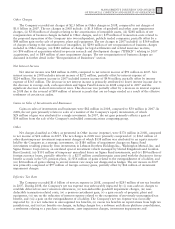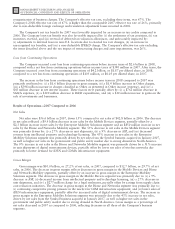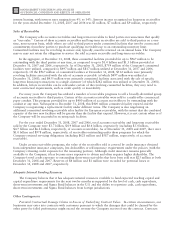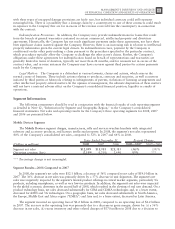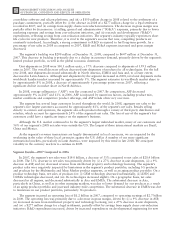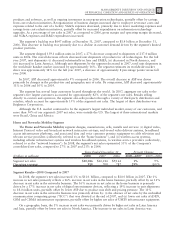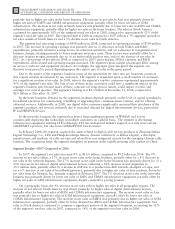Motorola 2008 Annual Report Download - page 63
Download and view the complete annual report
Please find page 63 of the 2008 Motorola annual report below. You can navigate through the pages in the report by either clicking on the pages listed below, or by using the keyword search tool below to find specific information within the annual report.
maturity of the Sigma Fund investments classified as non-current (excluding impaired securities) was 16 months.
At December 31, 2007, none of the Sigma Fund investments were classified as non-current.
Prior to the fourth quarter of 2008, the Company recognized impairment charges from Sigma Fund investments
in its consolidated statements of operations and temporary unrealized losses in Sigma Fund investments as a
component of Non-owner changes to equity in the consolidated statements of stockholders’ equity. During the fourth
quarter of 2008, the Company determined that temporary unrealized losses in Sigma Fund investments should also
be recognized in the Company’s consolidated statements of operations, even though the related securities were not
considered impaired. Because the Sigma Fund uses investment-company accounting in its stand-alone financial
statements, it marks the investments in the fund to market and records all unrealized gains or losses in earnings,
whether or not the related securities are considered impaired. The Company has determined that the stand-alone
accounting policies of the Sigma Fund should be retained in its consolidated financial statements. Accordingly, the
Company recorded $101 million of accumulated temporary unrealized losses in Sigma Fund investments in the
Company’s consolidated statements of operations during the fourth quarter of 2008, which represents all of the
temporary unrealized gains and losses that have accumulated in Sigma Fund investments as of December 31, 2008.
Portions of the temporary unrealized losses recognized in the fourth quarter of 2008 arose in periods prior to the
fourth quarter of 2008 and should have been reflected in the Company’s consolidated statements of operations in the
periods in which they arose. The Company has determined that the impact of the amounts that arose in prior periods
is not material to the consolidated results of operations of those prior periods.
During 2008, the Company recorded total charges related to Sigma Fund investments, including temporary
unrealized losses and impairment charges, of $287 million in its consolidated statement of operations. During
2007, the Company recorded total charges of $18 million, all of which were impairment charges, in its
consolidated statements of operations. There were no temporary unrealized losses or impairment charges in the
Sigma Fund investment portfolio during 2006.
The Company continuously assesses its cash needs and continues to believe that the balance of cash and cash
equivalents, short-term investments and investments in the Sigma Fund classified as current are more than
adequate to meet its current operating requirements over the next twelve months. Therefore, the Company believes
it is prudent to hold the $466 million of securities classified as non-current to maturity (or until they recover to
cost), at which time we anticipate the securities will liquidate at cost.
Strategic Acquisitions and Investments: The Company used net cash for acquisitions and new investment
activities of $282 million in 2008, compared to net cash used of $4.6 billion in 2007 and net cash used of
$1.1 billion in 2006. During 2008, the Company: (i) acquired a controlling interest in Vertex Standard Co. Ltd.
(part of the Enterprise Mobility Solutions segment), (ii) acquired the assets related to digital cable set-top products
of Zhejiang Dahua Digital Technology Co., LTD. and Hangzhou Image Silicon, known collectively as Dahua
Digital (part of the Home and Networks Mobility segment), (iii) completed the acquisition of Soundbuzz Pte. Ltd.
(part of the Mobile Devices segment), and (iv) completed the acquisition of AirDefense, Inc. (part of the Enterprise
Mobility Solutions segment). The largest components of the $4.6 billion in 2007 expenditures were: (i) $3.5 billion
for the acquisition of Symbol Technologies, Inc. (part of the Enterprise Mobility Solutions segment),
(ii) $438 million for the acquisition of Good Technology, Inc. (part of the Enterprise Mobility Solutions segment),
(iii) $183 million for the acquisition of Netopia, Inc. (part of the Home and Networks Mobility segment),
(iv) $137 million for the acquisition of Terayon Communications Systems (part of the Home and Networks
Mobility segment), (v) the acquisition of Tut Systems, Inc. (part of the Home and Networks Mobility segment),
(vi) the acquisition of Modulus Video, Inc. (part of the Home and Networks Mobility segment), and (vii) the
acquisition of Leapstone Systems, Inc. (part of the Home and Networks Mobility segment).
Capital Expenditures: Capital expenditures were $504 million in 2008, compared to $527 million in 2007
and $649 million in 2006. The Company’s emphasis in making capital expenditures is to focus on strategic
investments driven by customer demand and new design capability.
Sales of Investments and Businesses: The Company received $93 million in proceeds from the sales of
investments and businesses in 2008, compared to proceeds of $411 million in 2007 and proceeds of $2.0 billion in
2006. The $93 million in proceeds in 2008 were primarily comprised of net proceeds received in connection with
the sales of certain of the Company’s equity investments. The $411 million in proceeds in 2007 were primarily
comprised of $346 million from the sale of the Company’s embedded communications computing business. During
the first half of 2009, the Company expects to close on the sale of its biometrics business.
Short-Term Investments: At December 31, 2008, the Company had $225 million in short-term investments
(which are highly-liquid fixed-income investments with an original maturity greater than three months but less
than one year), compared to $612 million of short-term investments at December 31, 2007.
55
MANAGEMENT’S DISCUSSION AND ANALYSIS
OF FINANCIAL CONDITION AND RESULTS OF OPERATIONS


